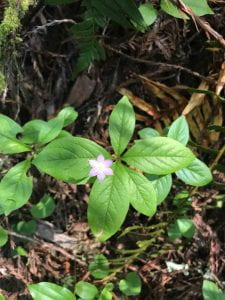Mt.Tam Steep Ravine, Rocky Point Rd
Coordinates: 37.9235° N, 122.5965° W
We visited Mt.Tamalpais again, and this time we hiked down to the point of Steep Ravine Canyon along the coast offering shady forest and a section of redwood forest. We could see the beautiful views of Stinson Beach and the Steep Ravine cabins. The cool thing about the coast is that if you’re lucky you can also see the whales!! The open spaces were full of water availability that many plants who are successful in the moist environment were successful there unlike last time when we were at the serpentine grasslands. During the hike we could see a diverse plant species including oaks, California bays, redwoods, ferns and more!
Viola sempervirens
Viola sempervirens, also known as Redwood Violet, is a native perennial species. The first thing I noticed was that the leaves are enormous! They were bigger than the flower which is kind of unique. The leaves are simple and evergreen; basal1-5 per caudex, petiole 2-16cm, the ovate to round blade is 1-4.5cm, 2-3.9cm wide. The inflorescence is axillary, and 5-10cm penduncle. The flowers are sepals lanceolate, often purple-streaked or spotted and not ciliate. The petals are lemon-yellow, lower 3 veined brown-purple, lateral 2 beared with cylindric hairs, lowest 8-17mm. They are usually found in shady areas in coastal forest in elevations between 5-1400m. The flowering time is around January through July.
Aquilegia formosa
Aquilegia formosa, also known as Columbine, is a native perennial herb that is a part of Iridaceae family. The first thing I noticed was that very vibrant red color and unique petal shape at the tips. That vibrant red color of flowers attract hummingbirds for pollination. The habit is glabrous, glaucous at least proximally. The elaves are basa, lower cauline generally 2-ternate, and petioles are between 5-30cm, leaflets 7-45mm with upper cauline generally simple to deeply 3-lobed. The sepals are about 10-20mm, tip is about 1.5-4mm wide, and stamens about 10-18mm. They can be easily found in streambanks, seeps, moist places, chaparral, oak woodland, mixed evergreen or confifer forests. They usually live in elevation less than 3300m and its flowering time is around April until September.
Trientalis latifolia
Trientalis latifolia, also known as Western Star flower is a native perennial herb that is part of Primulaceae family. It can easily found in shaded and moist area and it grows pretty short compared to other species. The stem is erect, about 5-30cm. The leaves are whorl near stem tip, blade is ovate to obovate, about 25-90mm. The flowers are in parts of 5 or 7, and calyx lobes 5-7mm, corolla 8-15mm wide, generally pink to rose, stamens 5-7mm. The sepals are more or less free and are persistent. They usually live in shaded places especially woodland in elevation less than 1400m. The flowering time is around April to July.
Narrative: This field trip was the last one before the field final! I was a bit disappointed at first because we were going to Mt.Tam again, but the habitat was very different compared to last one. Unlike last one when we found many species living in the serpentine soil, this time we get to see a lot of species that thrive in a shaded and moist area. The giant redwood forests made me feel such a small person, and I got to appreciate the motherland nature around us. The hike was more fun and adventurous especially the ladder we climbed down during the hike!! I felt like we were the Indiana Jones! After we survived from the jungle, we got to see the beautiful Stinson beach and the cabin along the coast. We were unlucky that we didn’t get to see the whales but next time I will!
Additional Photos!
Adenocaulon bicolor, part of Asteraceae
Myosotis latifolia, part of Boraginaceae
Athyrium filix-femina part of Woodsiaceae family
Ageratina adenophora, part of Asteraceae









